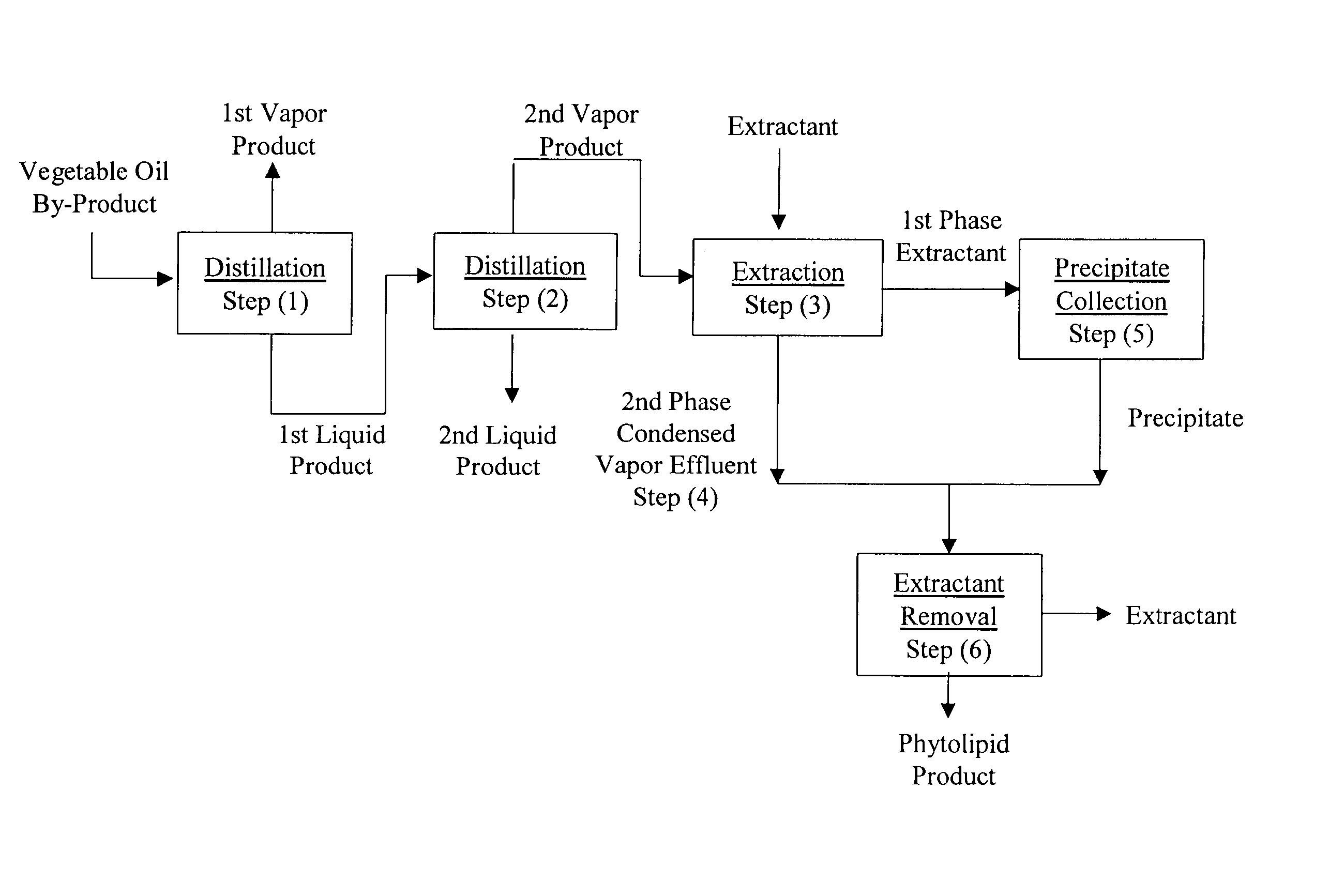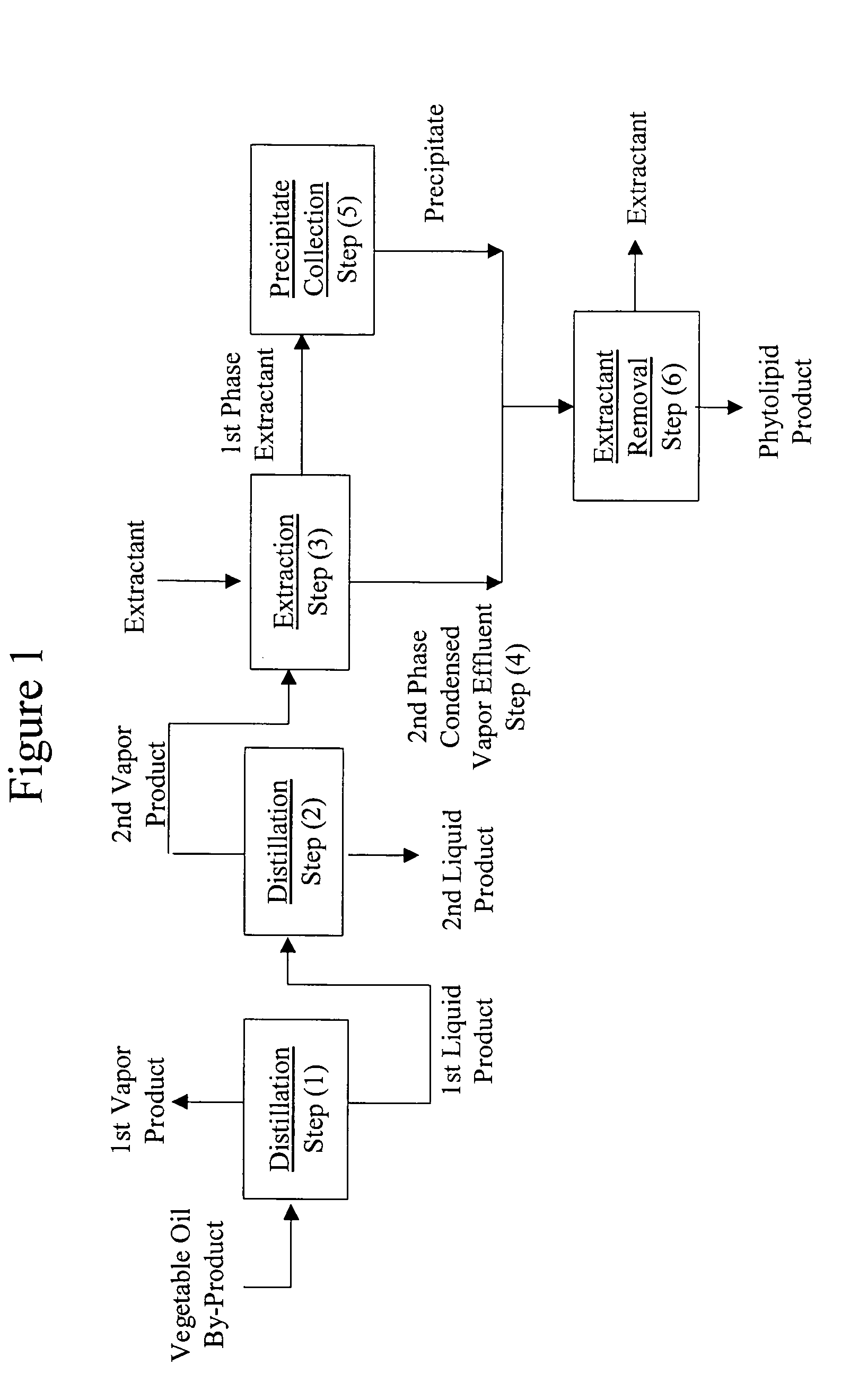Process for the recovery of a phytolipid composition
a phytolipid composition and recovery technology, applied in the field of phytolipid composition recovery, can solve the problems of reducing the overall recoverable yield and requiring an additional step to neutralize the basic methanol layer
- Summary
- Abstract
- Description
- Claims
- Application Information
AI Technical Summary
Benefits of technology
Problems solved by technology
Method used
Image
Examples
example 1
A 3.8 cm (1.5 inches) diameter vacuum-jacketed glass distillation column was equipped with a vacuum pump, refluxing distillation head, reflux ratio controller, metered feed pump, heated feed line, heated feed tank, and collection vessels for the distillate and bottoms product. The column was composed of a rectification section containing 22.9 cm (9 inches) of structured packing below the feed point and a stripping section containing 35.6 cm (14 inches) (both containing structured packing). A reboiler section comprised a 10.2 cm (4 inch) inside diameter, wiped film evaporator with an 45.7 cm (18 inches) length zone that was heated with a hot oil bath and auxiliarily heated with glass jacketed heating sleeve. The non-heated zones were insulated to prevent excessive heat loss. Rice bran fatty acid distillate (RBFAD) containing approximately 30% fatty acid and other low boiling components was fed continuously to the column at a rate of 500 ml / hour while the reboiler temperature was mai...
example 2
This example describes the continuous operation of the recovery process with reference to accompanying FIG. 1. Distillation Step (1) The vegetable oil by-product, rice bran oil distillate, is fed continuously at a rate of 45.5 kg per hour to distillation step (1). The distillation unit for step (1) comprises two falling film evaporators of 0.38 and 0.8 square meters heated surface, and a thin-film evaporator with a 0.3 square meter heated surface. The distillation unit is operated at a temperature of 240 to 290° C. and a pressure of about 0.2 to 20 torr. The vapor product in step (1) is condensed and removed from the process. The first liquid product is pumped from distillation step (1) at a rate of 32.7 kg per hour to distillation step (2). Distillation Step (2) The distillation unit of Step (2) is a short-path evaporator with a 0.8 square meter heated surface. Distillation step (2) is operated at a temperature of 240 to 260° C. and a pressure of 0.0005 to 0.05 torr to produce a...
example 3
A phytochemical composition produced in accordance with the procedure of Example 1 was determined to have the following composition:
Squalene27.3%Sterols10 to 35.0% comprised of campesterol, alpha andbeta-sitosterol, cycloartenol, brassi-casterol anddehydrocampesterol;Tocopherols4.2 wt %Tocotrienols1.9 wt %Rice Bran WaxRemainder of total composition
This composition was applied directly to the skin and lips. The composition has a very smooth feel on the skin and provides a moisturizing effect to skin and lips.
PUM
| Property | Measurement | Unit |
|---|---|---|
| pressure | aaaaa | aaaaa |
| temperature | aaaaa | aaaaa |
| pressure | aaaaa | aaaaa |
Abstract
Description
Claims
Application Information
 Login to View More
Login to View More - R&D
- Intellectual Property
- Life Sciences
- Materials
- Tech Scout
- Unparalleled Data Quality
- Higher Quality Content
- 60% Fewer Hallucinations
Browse by: Latest US Patents, China's latest patents, Technical Efficacy Thesaurus, Application Domain, Technology Topic, Popular Technical Reports.
© 2025 PatSnap. All rights reserved.Legal|Privacy policy|Modern Slavery Act Transparency Statement|Sitemap|About US| Contact US: help@patsnap.com


